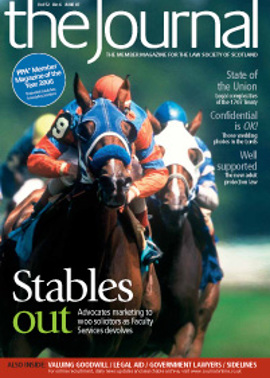Letters of Engagement Roadshow

The Scottish Legal Complaints Commission is likely to come into operation on 1 October 2008, or perhaps even sooner. It will have the power to award compensation for service complaints (including those with an element of negligence) up to a maximum limit of £20,000.
How can practices minimise the risk of complaints and claims and provide themselves with the best possible defence in the event that a complaint or claim is made?
When a practice is considering taking on a new client or a new piece of work, client and transaction vetting are critical. But once the practice has decided to take on that client or that new piece of work, letters of engagement, if properly drafted, have a key role to play in managing the relationship with the client, including the client’s expectations, and thereby minimising the risk of complaints and claims.
With these considerations in mind, the Society devised the letters of engagement roadshow to demonstrate how terms of engagement can be used to address common causes of complaints and claims, and to encourage practices to review, and, if necessary, strengthen their terms of engagement. Presentations were given by a representative of the Society on professional practice issues, including the compulsory elements set forth in the Solicitors (Scotland) (Client Communication) Practice Rules 2005, by a representative of the Society on managing expectations and avoiding complaints, and by a representative of Marsh about risk management and minimising the risk of claims.
Claims experience
Claims have arisen in circumstances where a more rigorous approach to terms of engagement could have prevented them. Consider these case studies:
Who is the client?
The firm was instructed by A Ltd to prepare a standard security over Mr B’s house to secure a guarantee granted by Mr B to A Ltd. The firm had previously represented Mr B in other matters and he regarded them as his solicitors. Questions arose in a subsequent claim whether the firm was protecting Mr B’s interests and whether Mr B was entitled to regard the firm as acting for him.
Be clear in terms of engagement (and, where appropriate, by issuing non-engagement letter(s)) who is and who is not your client, especially in multi-party situations. Even though you may be clear that you are not acting for someone, that person may, whether justified or not, think you are representing their interests.
Failure to scope the engagement properly
The firm acted for a new client in acquiring an option to purchase agricultural land for a proposed housing development. Although the documenting of the option was completed satisfactorily, ultimately, a notice exercising the option was not issued on time. When the client realised that he had lost the option, he blamed the firm for not reminding him of the critical date and pointed out that his former solicitors had always flagged critical dates in other similar transactions.
Be clear about responsibilities for critical dates and set these out clearly in terms of engagement. While it may have been sufficient under the Solicitors (Scotland) (Client Communication) Practice Rules 2005 to define the scope of work simply as “the acquisition of an option to purchase”, from a risk management point of view you need to go further and specify not only what you are going to do but, equally importantly, what you are not going to do.
You may be clear what work is encompassed within your description of the scope of the engagement, but is the client? As in the case study, clients may have their own expectations, sometimes based on previous experience, and a shared understanding with the client at the outset about what work you will and will not do is essential.
Alleged delay/misunderstanding regarding timescale
A firm acted for a client in commercial matters. He instructed the firm to handle his aunt’s executry. After five months he complained to the managing partner of “unacceptable delay” and threatened to take all of his business elsewhere.
In a survey of firms carried out by Marsh in 2004, approximately 40% of respondents indicated either that they did not say anything about timescales at all in their terms of engagement, or, if they did so, they only mentioned timescales occasionally. Of course, it may be impossible to specify how long a piece of work might take, but it is likely that the client will have their own expectations of timescale and these are best managed in terms of engagement. In relation to executry administration, many firms spell out the minimum timescale and the uncontrollable factors that may result in the timescale being longer, sometimes much longer.
Failure to comply with terms of engagement
It may seem obvious, but do make sure that you actually do what you say you are going to do in your terms of engagement. If you do not do so, at the very least you will have a client with a cause for dissatisfaction, complaint or claim.
Claims have sometimes arisen from allegations that the solicitor has failed to follow the client’s instructions, or acted contrary to instructions or without instructions. In many of these situations, the problem is a misunderstanding between solicitor and client which could have been avoided by setting out the position clearly in the terms of engagement.
Manage the client
Terms of engagement are the ideal opportunity, at the very start of the relationship, to set out clearly how, how often and when you will communicate with the client. It is also an opportunity to specify the client’s responsibilities, for example for giving instructions timeously when requested, checking that you have received emails and faxes he has sent you, and informing you of any change of contact details such as address or mobile phone number.
How well are you doing?
The above case studies give only a flavour of the problems that could be avoided. Could the claims described in the case studies happen to you?
- No?
- Why not?
- Yes?
- How are you addressing these areas of risk?
Even if you believe you can satisfactorily answer these questions, there are some critical questions you might ask yourself:
- Could your terms of engagement be better scoped?
- For example, do you explicitly include/exclude responsibility for flagging post-completion deadlines, or advising on taxation issues?
- Are you confident colleagues use only the firm’s approved style of terms of engagement? How do you know?
- Are terms of engagement reviewed to ensure that they have been complied with?
- Will you be able to evidence terms of engagement 5/10/15/20 years from now when you need to? Remember that claims may arise many years after the work has been carried out and the file closed/destroyed.
- How is compliance with the Practice Rules checked? What is your current performance rating?
- Terms of engagement need to be kept under periodic review and the following three stage review process is suggested:
- Conduct file audits to identify weaknesses/gaps
- Analyse any complaints, claims, “near misses”, loss of clients etc to identify weaknesses/gaps where the analysis reveals that the underlying cause is a problem with the terms of engagement, or one that could have been addressed by provisions in terms of engagement
- Prioritise and address weaknesses/gaps.
In identifying weaknesses/gaps in your terms of engagement, a self-assessment and benchmarking exercise may prove helpful.
Self-assessment
There is a straightforward online self-assessment tool on terms of engagement available on the Marsh website for Scottish solicitors – www.marsh.co.uk/lawsociety – for which all practices have a username and password.
If you have forgotten your login details, please contact the author at the undernoted email address. The self-assessment tool requires you to answer a number of questions about your approach to your terms of engagement. It takes only a few minutes to complete. When you have completed it, you can print off a report based on the answers you have given.
Benchmarking
It is often useful to compare and contrast your approach with what others are doing. Terms of engagement are no exception. Many practices publish their terms of engagement on their website. If you wish to compare your terms of engagement with those used by other firms, type “terms of engagement solicitors” into a search engine such as Google, and you will come up with hundreds of examples. In this way, Marsh carried out a simple benchmarking exercise for the purpose of the letters of engagement roadshow.
We looked at the terms of engagement of 10 randomly selected firms north and south of the border to find out whether they included certain pre-selected clauses. The results are shown in the table.
How do your terms of engagement compare?
RUSSEL LANG AND MARSH
Russell Lang is a former solicitor in private practice who works in the FinPro (Financial and Professional Risks) National Practice at Marsh, the world’s leading risk and insurance services firm. To contact Russell, email: russell.x.lang@marsh.com .
The information contained in this article provides only a general overview of subjects covered, is not intended to be taken as advice regarding any individual situation and should not be relied upon as such. Insureds should consult their insurance and legal advisers regarding specific coverage issues.
Marsh Ltd is authorised and regulated by the Financial Services Authority.
In this issue
- Court plans with little appeal
- Winning ways
- Forward steps
- Bar to progress
- Dean urges solicitors to stay with fee scheme
- The Union and the law
- Public and confidential
- Adult support: a new generation
- Advice deserts and PDSOs
- Vision 20:20
- Benevolent Fund: a much valued support
- Termites in the basement
- The value of goodwill
- Letters of Engagement Roadshow
- A door almost shut
- Lessons in improvements
- Null from the outset?
- The Tevez affair
- Scottish Solicitors' Discipline Tribunal
- Website reviews
- Book reviews
- Held in check
- Possession undisturbed






